engine YAMAHA EX 2020 ΟΔΗΓΌΣ ΧΡΉΣΗΣ (in Greek)
[x] Cancel search | Manufacturer: YAMAHA, Model Year: 2020, Model line: EX, Model: YAMAHA EX 2020Pages: 198, PDF Size: 5.03 MB
Page 5 of 198

E
F
D
E
S
P
G
R
I
Contents
Introduction............................................................................ 1
Important information........................................................... 2
How to use this guide to practice........................................ 4
Exercise 1: Controls............................................................... 6
Exercise 2: Starting and stopping engine............................ 7
Exercise 3: Boarding and balancing................................... 10
Exercise 4: Trolling speed maneuvering............................ 13
Exercise 5: Sub-planing speed maneuvering.................... 14
Exercise 6: Full acceleration and stopping....................... 17
Exercise 7: Planing speed operation.................................. 18
Exercise 8: Crossing wakes and swells............................. 20
Exercise 9: Operating with passengers............................. 21
Postscript............................................................................. 23
WaveRunner
EX / EX Sport / EX Deluxe
RIDING PRACTICE GUIDE
©2020 by Yamaha Motor Co., Ltd.
1st Edition, May 2019
All rights reserved.
Any reprinting or unauthorized use
without the written permission of
Yamaha Motor Co., Ltd.
is expressly prohibited.
Printed in U.S.A.
E_F3Y-72-forPrint.book Page 1 Friday, June 7, 2019 1:58 PM
Page 7 of 198
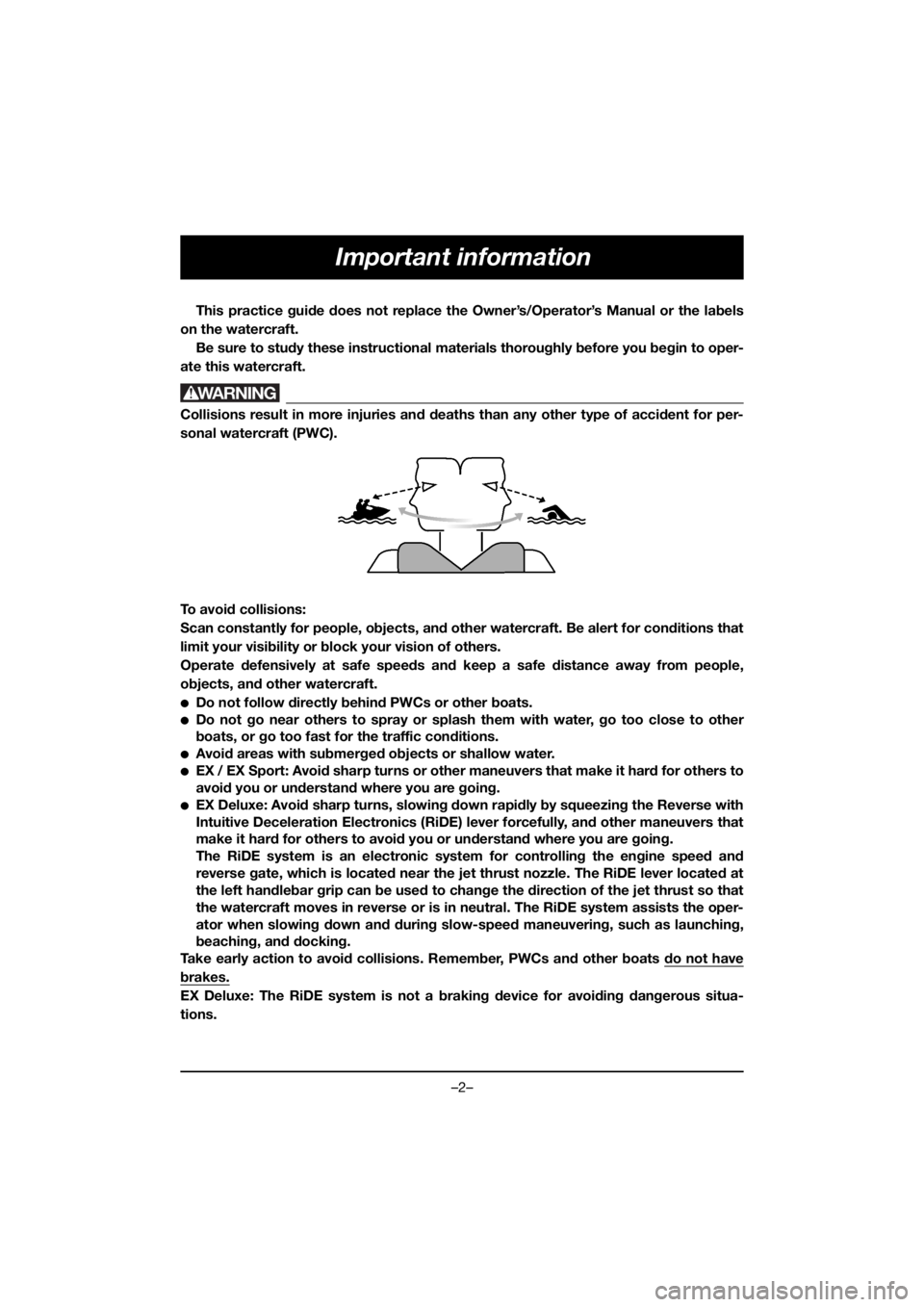
–2–
Important information
This practice guide does not replace the Owner’s/Operator’s Manual or the labels
on the watercraft.
Be sure to study these instructional materials thoroughly before you begin to oper-
ate this watercraft.
WWARNING
Collisions result in more injuries and deaths than any other type of accident for per-
sonal watercraft (PWC).
To avoid collisions:
Scan constantly for people, objects, and other watercraft. Be alert for conditions that
limit your visibility or block your vision of others.
Operate defensively at safe speeds and keep a safe distance away from people,
objects, and other watercraft.
●Do not follow directly behind PWCs or other boats.
●Do not go near others to spray or splash them with water, go too close to other
boats, or go too fast for the traffic conditions.
●Avoid areas with submerged objects or shallow water.
●EX / EX Sport: Avoid sharp turns or other maneuvers that make it hard for others to
avoid you or understand where you are going.
●EX Deluxe: Avoid sharp turns, slowing down rapidly by squeezing the Reverse with
Intuitive Deceleration Electronics (RiDE) lever forcefully, and other maneuvers that
make it hard for others to avoid you or understand where you are going.
The RiDE system is an electronic system for controlling the engine speed and
reverse gate, which is located near the jet thrust nozzle. The RiDE lever located at
the left handlebar grip can be used to change the direction of the jet thrust so that
the watercraft moves in reverse or is in neutral. The RiDE system assists the oper-
ator when slowing down and during slow-speed maneuvering, such as launching,
beaching, and docking.
Take early action to avoid collisions. Remember, PWCs and other boats do not have
brakes.
EX Deluxe: The RiDE system is not a braking device for avoiding dangerous situa-
tions.
E_F3Y-72-forPrint.book Page 2 Friday, June 7, 2019 1:58 PM
Page 11 of 198

–6–
Exercise 1: Controls
Objective:
This exercise trains you to locate and operate the watercraft’s controls without looking or
hesitating. You must master this skill so you can scan constantly for people, objects, and
other watercraft as you maneuver, rather than taking away concentration to find a control.
Skills:
Knowing where every control is and how to use it without having to stop and think about
it.
Directions:
Drill 1: Identifying the components and controls
Read your Owner’s/Operator’s Manual to identify the watercraft’s main components and
controls.
Do not just assume you know how a control works, read the instructions to be sure!
Drill 2: Pre-operation checks
Practice performing the pre-operation checks listed in your Owner’s/Operator’s Manual.
You learned where everything is in Drill 1.
Now make sure everything is working properly. Pay particular attention to the steering
controls and the throttle lever.
Drill 3: Operating positions
With the watercraft on land and the engine off, board and become familiar with the cor-
rect operating positions described in your Owner’s/Operator’s Manual. Then, with your
eyes facing straight ahead, locate each control and verify that you know how to use it.
Continue this drill until you feel comfortable with the controls.
E_F3Y-72-forPrint.book Page 6 Friday, June 7, 2019 1:58 PM
Page 12 of 198
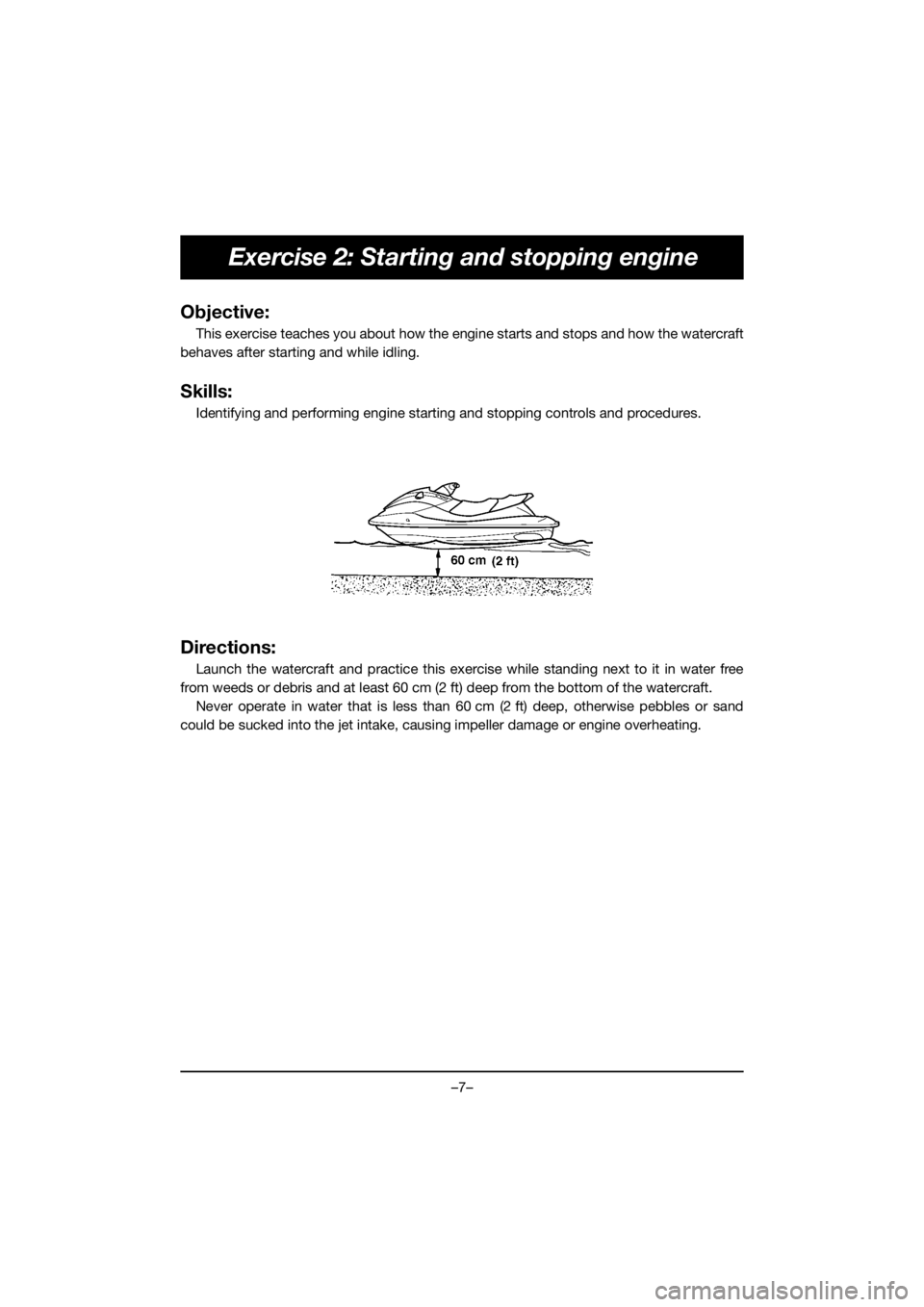
–7–
Exercise 2: Starting and stopping engine
Objective:
This exercise teaches you about how the engine starts and stops and how the watercraft
behaves after starting and while idling.
Skills:
Identifying and performing engine starting and stopping controls and procedures.
Directions:
Launch the watercraft and practice this exercise while standing next to it in water free
from weeds or debris and at least 60 cm (2 ft) deep from the bottom of the watercraft.
Never operate in water that is less than 60 cm (2 ft) deep, otherwise pebbles or sand
could be sucked into the jet intake, causing impeller damage or engine overheating.
E_F3Y-72-forPrint.book Page 7 Friday, June 7, 2019 1:58 PM
Page 13 of 198
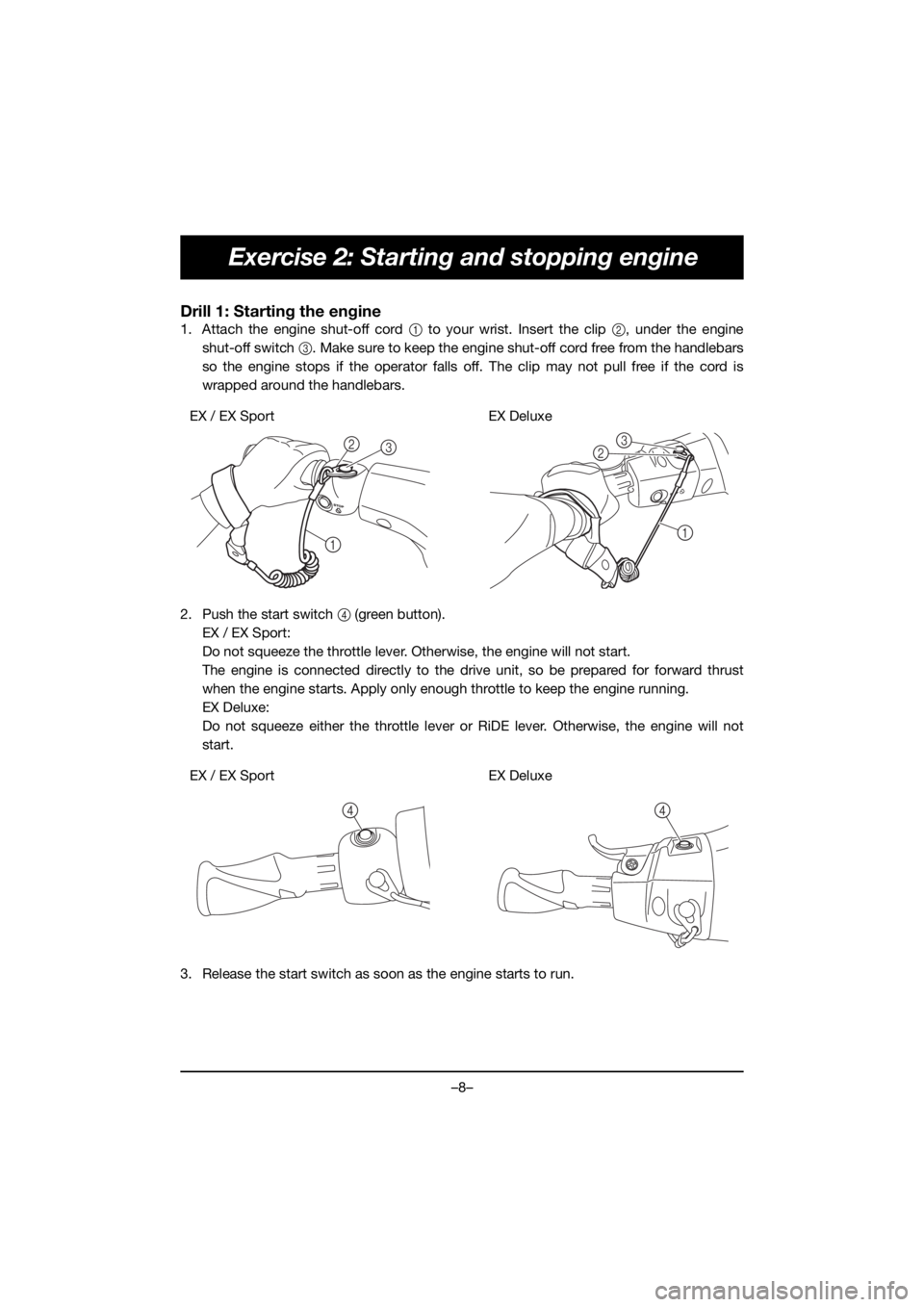
–8–
Exercise 2: Starting and stopping engine
Drill 1: Starting the engine
1. Attach the engine shut-off cord 1 to your wrist. Insert the clip 2, under the engine
shut-off switch 3. Make sure to keep the engine shut-off cord free from the handlebars
so the engine stops if the operator falls off. The clip may not pull free if the cord is
wrapped around the handlebars.
2. Push the start switch 4 (green button).
EX / EX Sport:
Do not squeeze the throttle lever. Otherwise, the engine will not start.
The engine is connected directly to the drive unit, so be prepared for forward thrust
when the engine starts. Apply only enough throttle to keep the engine running.
EX Deluxe:
Do not squeeze either the throttle lever or RiDE lever. Otherwise, the engine will not
start.
3. Release the start switch as soon as the engine starts to run.
2
3
123
1
EX / EX Sport EX Deluxe
44
EX / EX Sport EX Deluxe
E_F3Y-72-forPrint.book Page 8 Friday, June 7, 2019 1:58 PM
Page 14 of 198
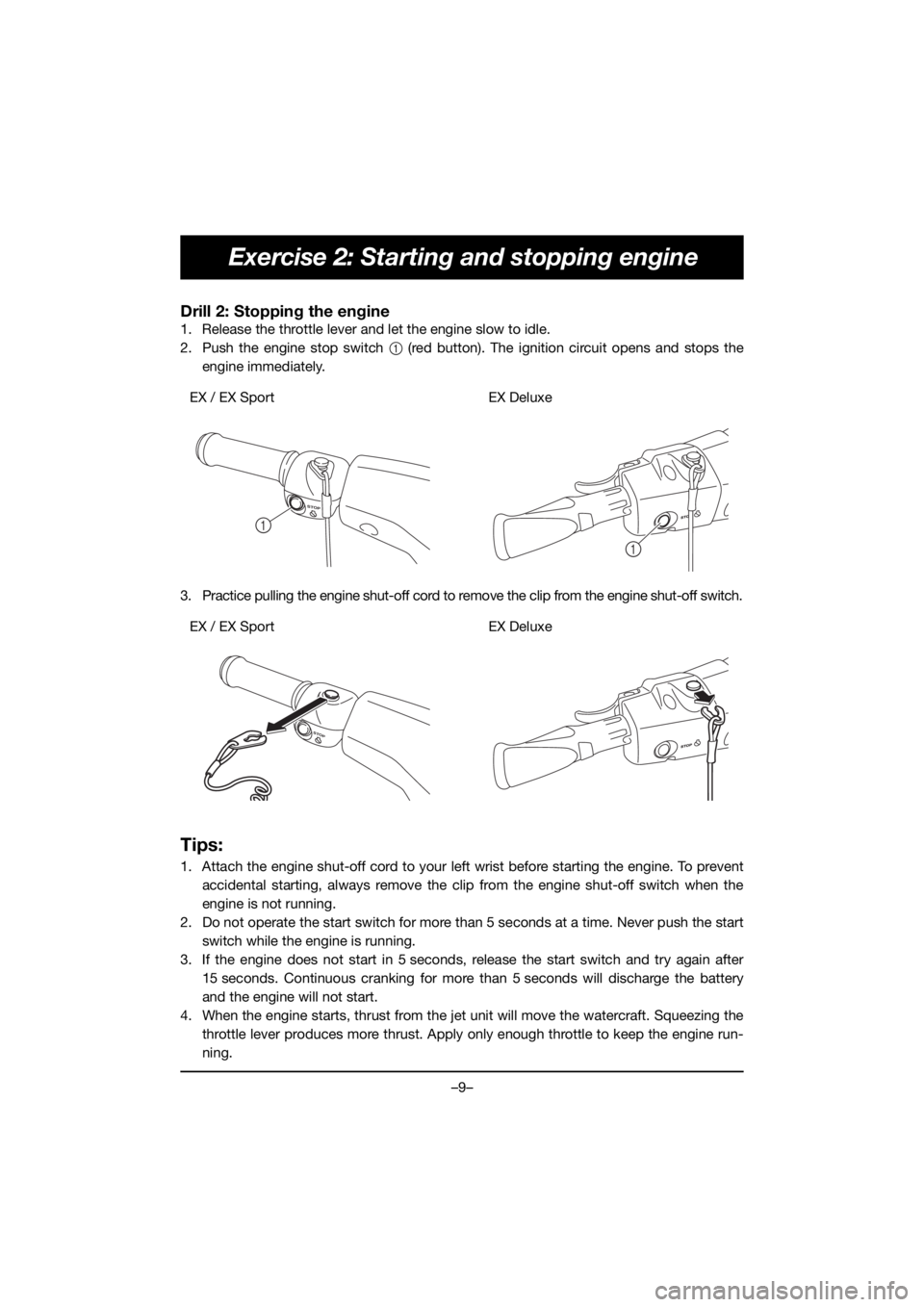
–9–
Exercise 2: Starting and stopping engine
Drill 2: Stopping the engine
1. Release the throttle lever and let the engine slow to idle.
2. Push the engine stop switch 1 (red button). The ignition circuit opens and stops the
engine immediately.
3. Practice pulling the engine shut-off cord to remove the clip from the engine shut-off switch.
Tips:
1. Attach the engine shut-off cord to your left wrist before starting the engine. To prevent
accidental starting, always remove the clip from the engine shut-off switch when the
engine is not running.
2. Do not operate the start switch for more than 5 seconds at a time. Never push the start
switch while the engine is running.
3. If the engine does not start in 5 seconds, release the start switch and try again after
15 seconds. Continuous cranking for more than 5 seconds will discharge the battery
and the engine will not start.
4. When the engine starts, thrust from the jet unit will move the watercraft. Squeezing the
throttle lever produces more thrust. Apply only enough throttle to keep the engine run-
ning.
1
STOP
1
EX / EX Sport EX Deluxe
STOP
EX / EX Sport EX Deluxe
E_F3Y-72-forPrint.book Page 9 Friday, June 7, 2019 1:58 PM
Page 15 of 198
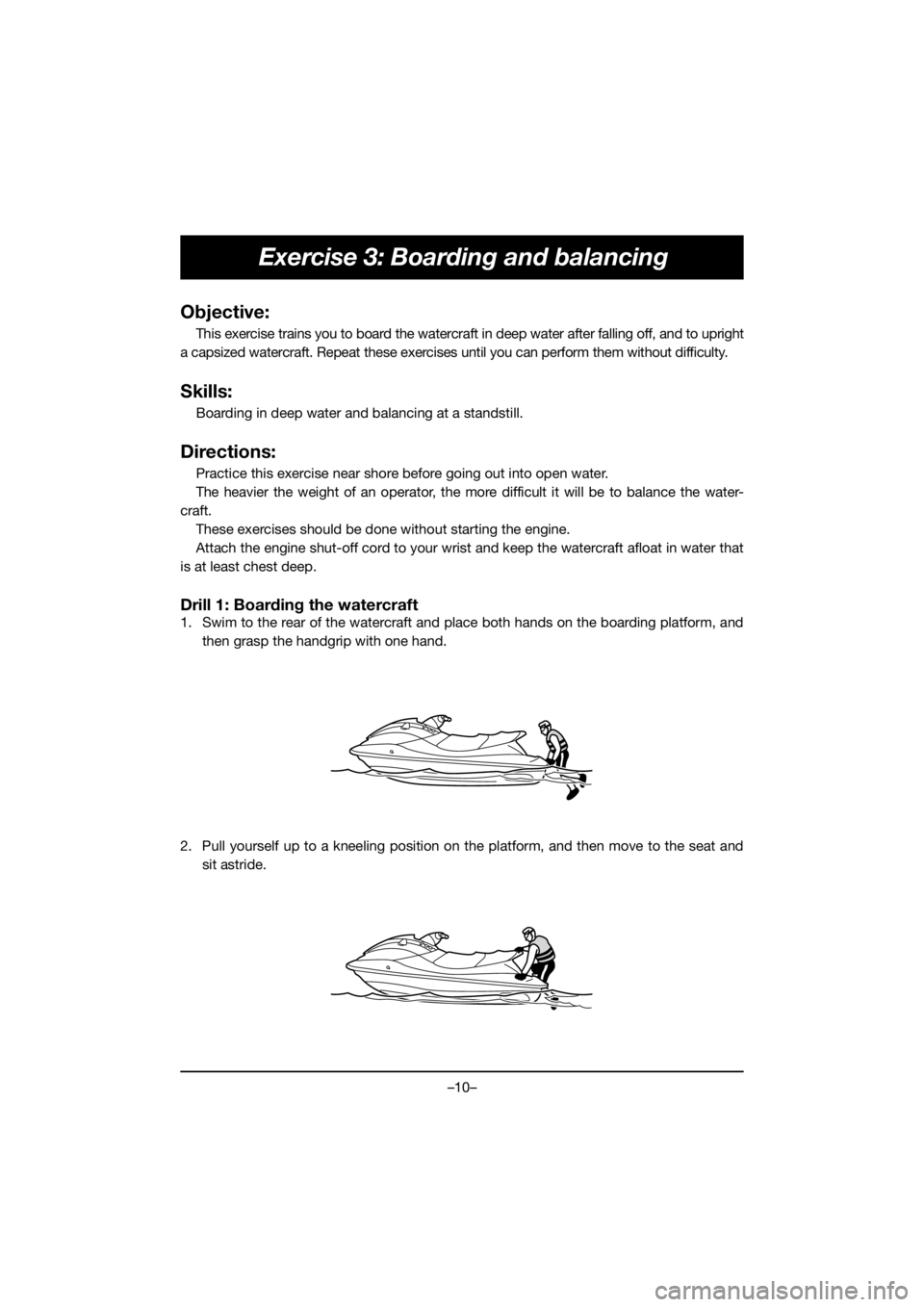
–10–
Exercise 3: Boarding and balancing
Objective:
This exercise trains you to board the watercraft in deep water after falling off, and to upright
a capsized watercraft. Repeat these exercises until you can perform them without difficulty.
Skills:
Boarding in deep water and balancing at a standstill.
Directions:
Practice this exercise near shore before going out into open water.
The heavier the weight of an operator, the more difficult it will be to balance the water-
craft.
These exercises should be done without starting the engine.
Attach the engine shut-off cord to your wrist and keep the watercraft afloat in water that
is at least chest deep.
Drill 1: Boarding the watercraft
1. Swim to the rear of the watercraft and place both hands on the boarding platform, and
then grasp the handgrip with one hand.
2. Pull yourself up to a kneeling position on the platform, and then move to the seat and
sit astride.
E_F3Y-72-forPrint.book Page 10 Friday, June 7, 2019 1:58 PM
Page 16 of 198
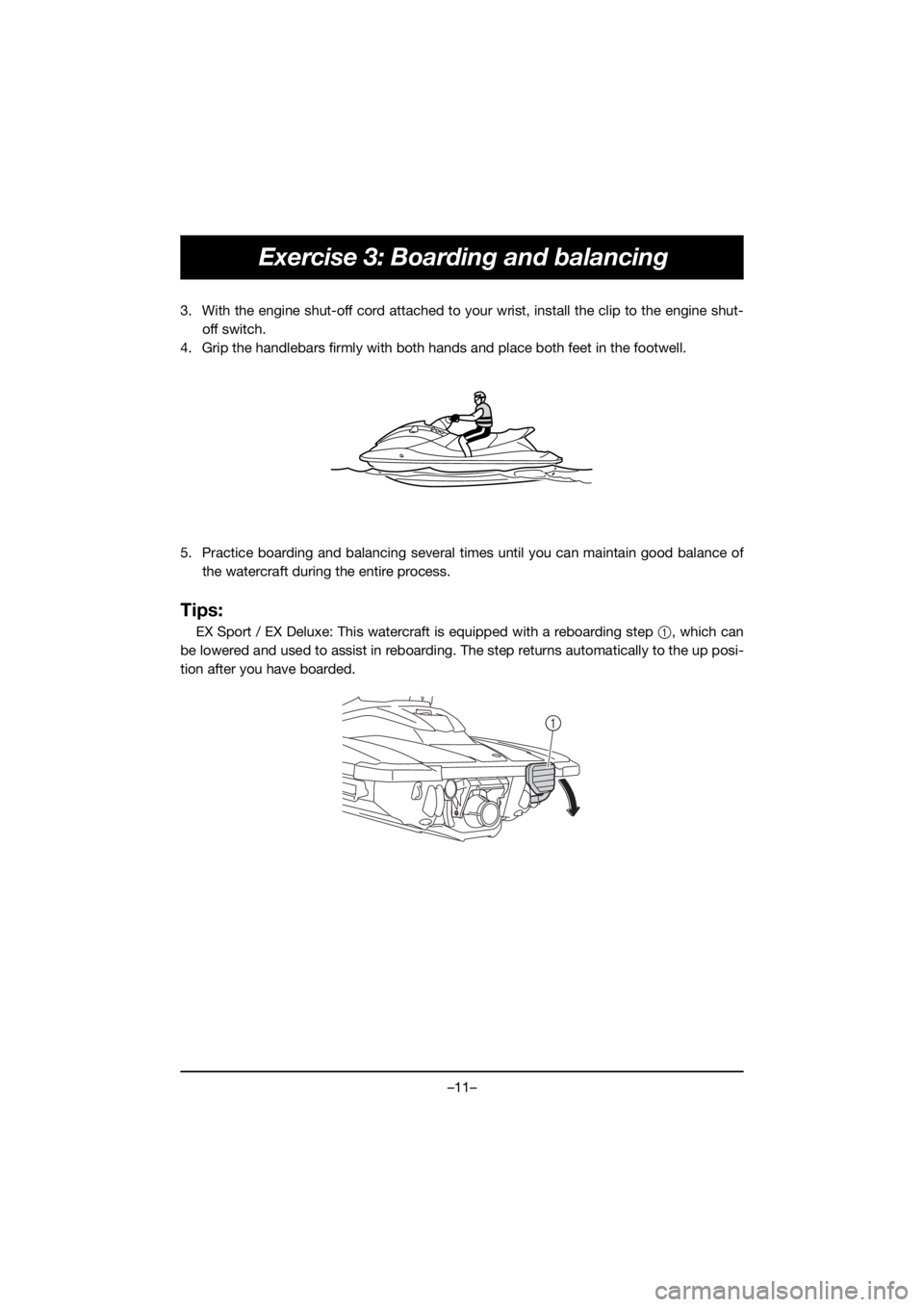
–11–
Exercise 3: Boarding and balancing
3. With the engine shut-off cord attached to your wrist, install the clip to the engine shut-
off switch.
4. Grip the handlebars firmly with both hands and place both feet in the footwell.
5. Practice boarding and balancing several times until you can maintain good balance of
the watercraft during the entire process.
Tips:
EX Sport / EX Deluxe: This watercraft is equipped with a reboarding step 1, which can
be lowered and used to assist in reboarding. The step returns automatically to the up posi-
tion after you have boarded.
1
E_F3Y-72-forPrint.book Page 11 Friday, June 7, 2019 1:58 PM
Page 17 of 198
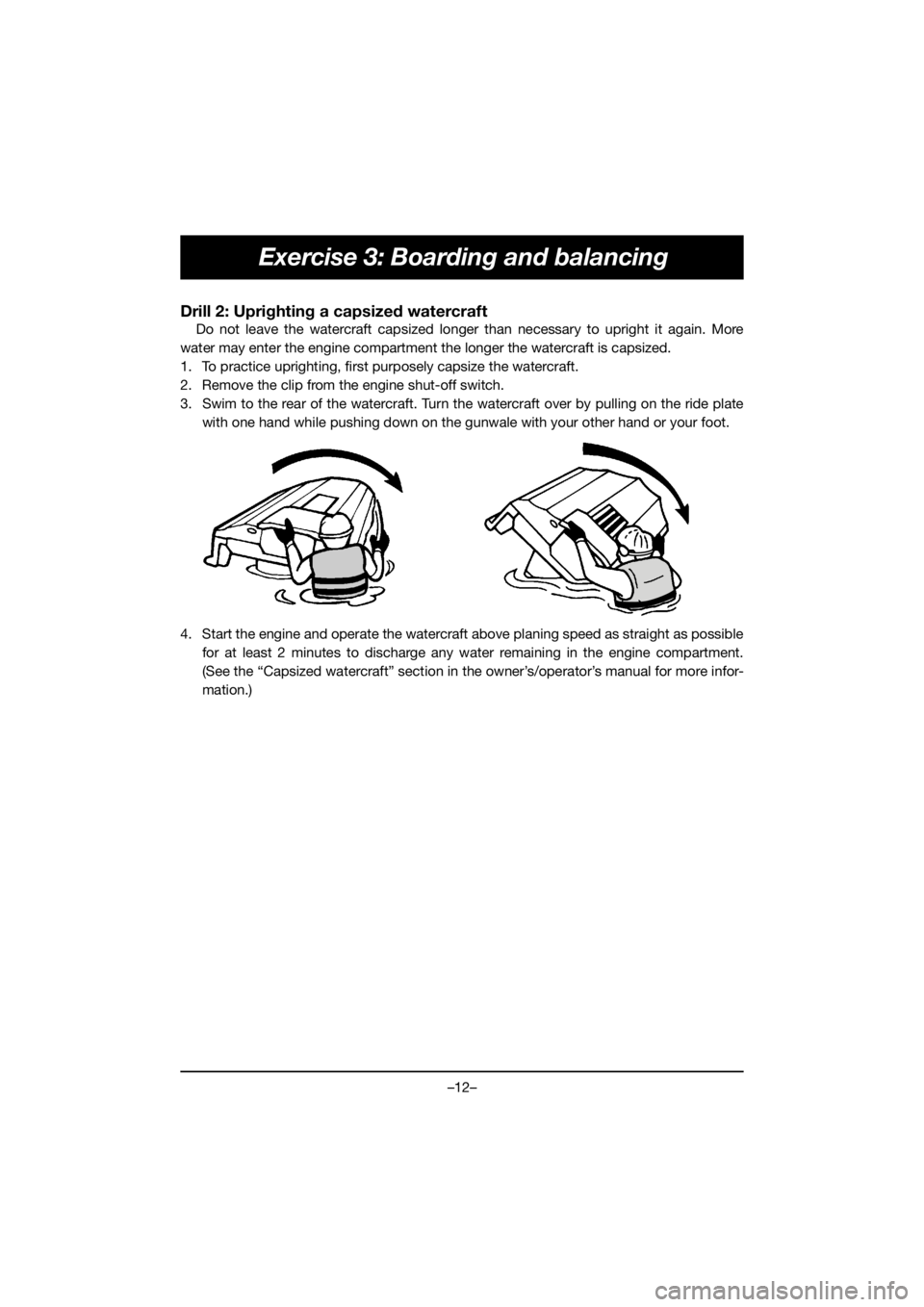
–12–
Exercise 3: Boarding and balancing
Drill 2: Uprighting a capsized watercraft
Do not leave the watercraft capsized longer than necessary to upright it again. More
water may enter the engine compartment the longer the watercraft is capsized.
1. To practice uprighting, first purposely capsize the watercraft.
2. Remove the clip from the engine shut-off switch.
3. Swim to the rear of the watercraft. Turn the watercraft over by pulling on the ride plate
with one hand while pushing down on the gunwale with your other hand or your foot.
4. Start the engine and operate the watercraft above planing speed as straight as possible
for at least 2 minutes to discharge any water remaining in the engine compartment.
(See the “Capsized watercraft” section in the owner’s/operator’s manual for more infor-
mation.)
E_F3Y-72-forPrint.book Page 12 Friday, June 7, 2019 1:58 PM
Page 18 of 198

–13–
Exercise 4: Trolling speed maneuvering
Objective:
This exercise familiarizes you with the watercraft’s handling characteristics at trolling
speed. It teaches techniques you will use when beaching, docking, or approaching
objects.
Skills:
Starting and turning at trolling speed.
Directions:
Drill 1: Moving straight and turning at trolling speed
1. Board the watercraft, and check for people, objects and other watercraft.
2. Start the engine and go straight ahead.
3. Begin to turn, making a large figure eight about 15–21 m (50–70 ft) long. Do not apply
throttle.
Drill 2: Making full-lock turns at trolling speed
1. Turn the handlebars as far as possible in either direction. Allow the watercraft to turn
360°.
2. Practice turning both clockwise and counterclockwise to get a feel for how the water-
craft responds to handlebar movement.
E_F3Y-72-forPrint.book Page 13 Friday, June 7, 2019 1:58 PM